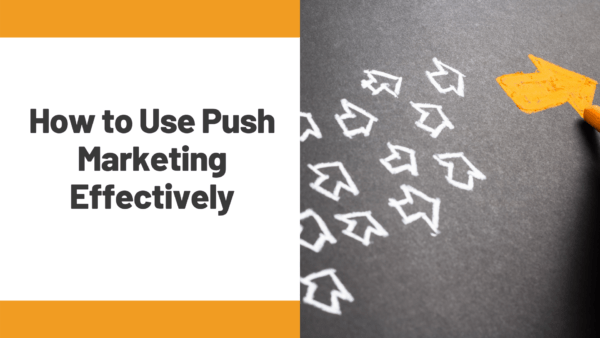
How to Use Push Marketing Effectively

Push marketing is an advertising strategy used to get your product or service in front of potential customers, rather than drawing customers in (pull marketing), which can take time and patience. Frequently push marketing is most associated with traditional advertising mediums, generated to raise awareness and reach as many people as possible even if they don’t have a desire or intent to purchase your product or service. Push marketing can be an extremely beneficial strategy to get your message in front of potential consumers. On the other hand, it can also be considered interruptive and annoying, ultimately harming your brand image. In this blog, we’re helping you break down the right time to use push marketing and when another marketing approach may be better.
When is push marketing helpful?
Push marketing is most helpful to generate awareness in a market where it doesn’t currently exist. Awareness can refer to consumer knowledge of a company or of a particular promotion.
Generating awareness can be done for both and could include efforts to make consumers aware of (and hopefully act on) a new business or brand, a new product launch, seasonal specials, or simply increasing brand recognition among an untapped market. Generating awareness is valuable to businesses, products, and services that don’t have a current demand in the marketplace, thus needing to develop it through push marketing.
Push marketing strategies focus on high reach and mass impressions, intended to get the message out to individuals who haven’t previously connected with the business.
Push marketing targets a broad audience and consists of paid options such as traditional advertising (TV, radio, print), paid search ads (Google Pay-Per-Click), and social media advertising. These paid advertising strategies have limited targeting capabilities and intend to get your message to individuals who wouldn’t otherwise find it organically. While this approach can build brand awareness and generate short-term revenue, it does little for your long-game marketing strategy.
When is it too much?
While push marketing can effectively bring individuals to a brand or product who wouldn’t otherwise find it, it can also be considered interruptive or even annoying. Think about it, none of us like commercials, and when given the opportunity to avoid them, most of us do. The same goes for display ads, social media advertisements, etc. We mindlessly scroll by unless something captures our interest and draws us in. We’re not saying that these avenues aren’t beneficial because they certainly are, but it’s essential to make sure you’re using push marketing effectively to reach the most appropriate target audience.
Beyond interrupting our favorite shows and social media timelines, we can all think of a brand that takes it too far. Maybe they advertise too much, and you can’t seem to escape them on any medium, or perhaps their advertisements are over the top and possibly offensive. These are cases when push marketing can work against you and end up hurting your brand image. Brands must find a delicate balance between capturing attention, generating awareness, and making their message memorable. It can be easy to overwhelm or annoy an audience if you don’t find that delicate balance.
Should I use push marketing?
Simply, yes. Push marketing at some capacity is beneficial to any marketing strategy. However, it’s important to find that fine balance that will resonate with your audience and not turn them off. A balanced push marketing strategy can be achieved through proper targeting. Don’t simply advertise everywhere with the intent of reaching everyone. Beyond being costly, that approach is not thoughtful or practical. Instead, pick out the channels that will work best for you based on who you’re targeting.
In addition to picking appropriate mediums, it’s vital to build a messaging strategy that resonates with your audience. Because you’re targeting people not already connected with your brand, it’s crucial to capture their attention and give them something to remember. Doing this will build that memory connection and hopefully create a lifelong customer.
Lastly, while you’re using push marketing tactics, it’s critical to be building your pull marketing strategy (inbound tactics that bring individuals to you). Pull marketing strategies include organic content development and SEO (search engine optimization). These strategies build your brand authority and ultimately help individuals find and connect with you when they’re searching. Pull marketing strategies are often more trustworthy and less invasive to the consumer.
If you’re ready to get pushing, you’ve come to the right place. The PTE team can help you find the perfect balance of push and pull strategies to connect your message to the appropriate audience. We have more than 15 years of experience finding perfect marketing mixes to help our clients reach their goals.
You May Like

The Importance of Setting Goals - for Career Success
Recently we had the opportunity to attend The Blue Chip Awards Luncheon. A wonderful afternoon filled with successful small business people, great food and inspirational stories, the highlight was key speaker, Nikki Stone. An Olympic gold medalist, Nikki overcame much adversity and physical challenges throughout her career and stressed the

Public Relations Strategy - 10 Steps to Ensure Success
As many of you know, I earned my APR (Accreditation in Public Relations) last year. Quite the process, I learned far more than I thought via studying assigned literature. One such piece, Cutlip & Center's Effective Public Relations 10th edition (EPR 10) was invaluable. Having practiced public relations for large

Networking: For Business and PR
Networking and communication used to take the traditional path of print advertising and brochures, direct mail, local/national trade shows, etc. These forms of communicating your brand/business still exist but more often they are used in balance with modern forms of networking and sharing information about you and your business. Here